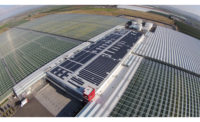Last year, Organic Valley, La Farge, Wis., announced what is said to be a first-of-its-kind community partnership that will enable it to become the largest food company in the world to source 100% of its electricity from renewable sources. We want our farms and our business to sustain and renew life.
Here’s what your company can do to achieve renewable energy.
Find your baseline. At the most basic level, companies must understand their plants’ energy consumption. This includes electricity, propane, natural gas, diesel and so on. You can’t improve what you don’t measure.
Decide what your goals are. For Organic Valley, our goal was to be 100% renewably powered. For others, something less than 100% might be more realistic. Many companies are setting what are called “science-based targets,” which are emissions-reduction goals in line with levels required to keep global temperature increases below 2°C, compared to pre-industrial levels. Going beyond electricity, we are working on ways to replace our propane and natural gas with renewable thermal alternatives.
Start with efficiency. Many businesses focus on adding new power sources. Cutting waste upfront will mean a smaller energy gap to address. Look closely at potential efficiency upgrades and take action on the low-hanging fruits. In all likelihood, your business has potential projects with pretty quick returns, 3-5 years in many cases. Then look to build on those successes and savings with a solar plan. Implement the projects that make the most sense for your facilities.
Install behind-the-meter solar where you can. Many of our facilities’ roofs are covered in solar panels, but this is still not enough to get us to 100%. For example, our Cashton, Wis., office is LEED Gold-certified and uses 55% less energy than a comparable commercial building, yet the rooftop solar accounts for only 10% of the electricity required for the building. Commercial buildings are simply more energy-intensive than residential. A good starting point is to add solar to existing real estate. And, look beyond your own properties, on the “other side” of the meter. Now it’s time to see what solar you can buy from the grid.
Install other renewables. Organic Valley’s first foray into large-scale renewables was the installation of the Cashton Greens Wind Farm, what was dubbed the first community wind farm in Wisconsin. Along with a local healthcare provider, we are co-owner of a 5 mw wind installation adjacent to our Cashton campus. We share the costs and the energy production. The wind energy and rooftop solar get us about halfway to 100% renewable. But, with our new Community Solar Project now underway, we will far exceed our electricity needs and help provide it to numerous rural communities by 2019.
Some of this innovative thinking includes:
1. Alternative ownership models. Organic Valley partnered with a third-party owner and operator to make Community Solar Project happen. This third party is putting up the capital and taking all the tax credits. We are contributing financially to the project through the purchase of renewable energy credits (RECs).
2. Building more solar than we need. This means there are additional REC purchasers and partners, which drives down the installation cost for the project as a whole and serves more people. This creates new opportunities for others to join and carve out their own portfolio of projects.
3. Successful partnerships. Thanks to a relationship with our local municipal utilities, municipal utility buying group and a third-party developer, we secured a power purchase agreement that works for everyone. Partners help by sharing capital investments, and longer-term relationships give adequate pay-off periods.
Organic Valley is a cooperative of farmers working together, and we have found that long-term relationships are the key to success in every part of our business, including renewable energy. We are in business for the long haul across generations of farmers, employees and consumers, and that requires us to think about all the ways to build true sustainability and improve in all aspects of our work.



